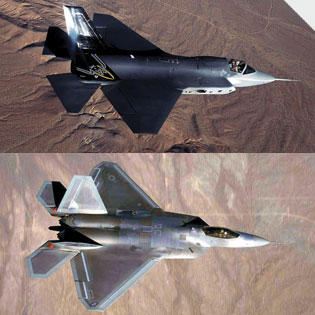 |
| What may come: The F-35A with Canadian markings. |
Fifth generation fallacy:
The predominant reason given for Canada's selection of the F-35 is that "it is the only fifth generation fighter available to Canada". This is true... Sort of. The F-22 Raptor was never made available for sale outside the U.S. Even if it was, it would be doubtful if Canada's relatively meager defense budget could afford a fighter that cost $200 million per copy and $44,000 per hour to fly. Even the U.S. government considers the fighter too expensive and has cut F-22 production.
 |
| The archetype: Lockheed Martin's F-22 Raptor. |
The F-35's marketing seems to suggest near F-22 level of performance for a much more affordable price. Since the F-35 is stated to be "Fifth Generation", it must have many of the F-22's benefits, right? Well... Not really.
 |
| Family resemblence: F-35(top) and F-22(bottom). |
Placed side-by-side, the family resemblance is clear. The F-35 looks very much like a smaller, single engine, F-22. Both are obviously stealthy designs, with internal weapon bays and similar layouts. Appearances can be deceiving however, as the F-35 lacks some of the F-22's key "fifth generation" features.
That one, single engine of the F-35 is unable to match the power-to-weight ratio of the F-22's massive twin engines. This leaves the F-35 incapable of supercruising. If the F-35 pilot wishes to go supersonic, afterburner power is the only option. This, of course, rapidly burns fuel and makes infrared tracking much easier. Top speed of the F-35 is said to be mach 1.6. This means it has a top speed less than the F-18s and F-16s it is meant to replace.
The F-35 also lacks the F-22's vectored thrust engine nozzles. This, combined with its relatively smaller wings and lack of any aerodynamic tricks like canards mean that it lacks the F-22 super-maneuverability. Worse still, the F-35's design suggests that it may offer little improvement over second generation fighters like the F-104 Starfighter and F-105 Starfighter. At the very best, it will offer little improvement over current fourth generation fighters like the F-18 and F-16.
Where the F-35 does shine is sensors and avionics. Making use of modern computing power, AESA radar, and infrared sensors, the F-35 should be able to offer its pilots a crystal clear picture of the battlefield. Combined with a data link capable of sharing information with friendly forces, the F-35 should actually prove superior to the F-22 in this department, despite having a physically smaller radar.
 |
| The F-35's cockpit discards traditional displays in favor of a single color screen and helmet mounted optics. |
 |
| Cloaking device? Not so much. |
Although a stealthy design, from the sides and front, the F-35 is not as stealthy as the F-22. From the rear, the F-35's traditional round engine makes it as stealthy as most other single engine fighters, which is to say, not at all. The F-35's stealthiness also takes a hit if it is required to mount any weapons or fuel tanks externally. More on this later.
So, despite being a "Fifth Generation" fighter, the F-35 simply doesn't offer all the features of the arch-typical Fifth Generation F-22. It doesn't offer supercruise, super-maneuverability, nor the same level of stealthiness. It does offer true "fifth generation" avionics, but many so called "Fourth generation plus" fighters do as well. If fighters like the Typhoon and Super Hornet can be considered "Fourth Plus" generation, maybe the F-35 should be considered a "Fifth minus" generation fighter.
No comments:
Post a Comment